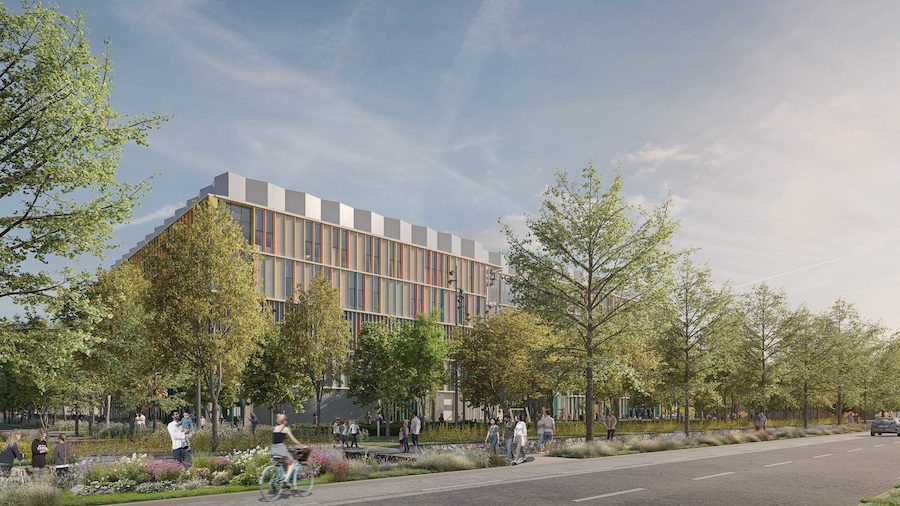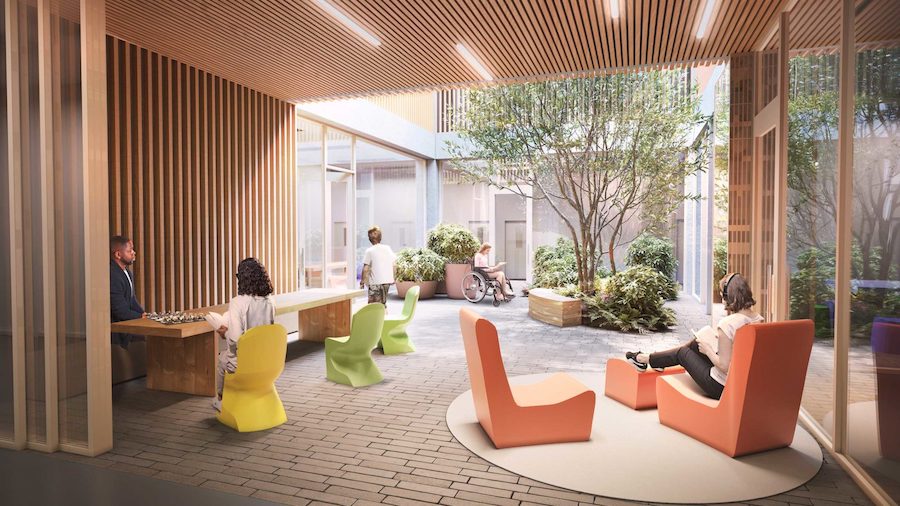Women & children's / New models of care
Plans submitted for Passivhaus-designed children’s hospital
By Andrew Sansom | 18 Oct 2021 | 0
Early design plans have been submitted to Cambridge City Council for what would be the region’s first dedicated children’s hospital, which would adopt a care model to treat the “whole child”, not just their illness.
The submission of the formal ‘reserved matters’ planning application for Cambridge Children’s Hospital builds on the existing outline planning permission, which was granted for the site previously. The early designs and floor plans were shared with the Council’s planning committee in August.
With an estimated total footprint of around 36,000 sq m, including 5000 sq m of research space, the drawings are an early indication of how the hospital might look when it opens in 2025. The plans also include details of possible future development for the hospital beyond 2025.
Built on the Cambridge Biomedical Campus, the state-of-the-art hospital hospital will care for children and young people from the counties of Norfolk, Suffolk, Essex, Hertfordshire, Bedfordshire and Cambridgeshire. Embedding genomic and psychological research alongside clinical expertise in physical and mental child health, Cambridge Children’s Hospital will pass on that knowledge to international hospitals and institutions, sharing ground-breaking research with the aim of benefiting as many young people as possible. 
“Big milestone”
There is still some way to go before building work can begin and the vision for this much-needed facility is realised. Work continues to develop the outline business case, which must be approved by HM Treasury, and on the fundraising campaign, which was announced earlier this year. Nevertheless, the planning submission represents an important landmark for the project.
Andrew Tollick, senior programme manager for design and construction at Cambridge Children’s Hospital, said: “This is a big milestone for Cambridge Children’s Hospital, not only in planning terms but in sharing our vision for ‘a whole new way’: one that integrates children’s mental and physical health services alongside world-class research to provide holistic, personalised care in a state-of-the-art facility.”
An international design team, comprised of experts from Turner & Townsend, Hawkins\Brown, White Arkitekter, Ramboll and MJ Medical, with support from planning consultants Bidwells and fire consultants Alfor, has been engaging with staff from across the partner organisations about how the hospital should work. Members of Cambridge Children’s Network, which is made up of children, young people, parents and carers from across the region, have also been instrumental in helping shape how the facility might look and feel in these early designs.
The hospital’s form is designed to encourage play and bring in light. Outdoor courtyards at all levels give children opportunities to interact, learn, empathise, and heal. Distributing these spaces throughout the building brings natural light and air into the depth of the plan, creating visual connections across wards, while dramatically reducing the building’s operational lighting requirements. The children’s hospital is designed with Passivhaus principles and is expected to meet BREAAM Excellent as a minimum.
 Green credentials
Green credentials
The environmental impact of Cambridge Children’s Hospital has been a major consideration in the development of these plans. The hospital aims to be an exemplar in sustainability as part of its role in providing a safer future for all. The hospital will include many outdoors spaces, including gardens, courtyards and terraces, to provide access to nature and spaces for play and relaxation that support biodiversity and wildlife. The main hospital building will itself be enclosed within a wide landscaped green perimeter that recreates the feel of a summer meadow.
Cristiana Caira, healthcare design lead architect at White Arkitekter, said: “The project’s holistic approach focusing on the whole child is ground-breaking and will hopefully inspire many generations of new hospitals.”
She notes that while redefining the boundaries between mental and physical health is already a point of discussion in the UK and Scandinavia, this project “turns the page in the history of hospital planning”, integrating physical and mental health of children and young people alongside the leading research of Cambridge University.
“It has been incredibly interesting to be part of this journey, and our amazing design team has worked closely with the staff, parents, and children to design a completely new typology of hospital that addresses all needs and aspirations,” added Caira. “The design of the whole building will be psychologically informed, founded in the knowledge that architecture contributes to healing and patient wellbeing. This will be a place to learn, play, heal and recover – indoors and out.”
Organisations involved


